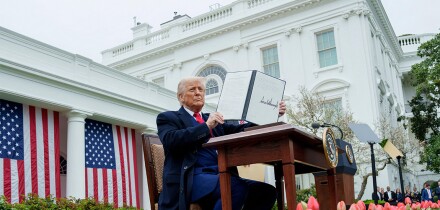Over 20 years since the first official over-the-counter derivative trade went public between IBM and the World Bank, the divide between the OTC and exchange-traded derivatives industries is as wide as ever. Although many firms trade both types, the individual participants in those shops still tend to think of themselves as either a swaps or a futures person. Such division can best be understood by appreciating the regulatory battle in the U.S. over swap regulation. Although much of that battle ended in 2000 with the passage of the Commodity Futures Modernization Act, defining differences continue to distinguish the two industries.
The substantive similarities between swaps and futures are startling given the historical divisions of the industries. Both are defined as derivative transactions. The U.S. General Accounting Office defines a derivative transaction as "a financial contract whose value depends on the values of one or more underlying assets or indices of asset values." In other words, the contract's fair market value will generally be linked to the movement of the values of the underlying asset or index that a particular contract references, a characteristic of both swaps and futures.
Both futures and swaps are used to hedge, speculate and deal in similar risks. Both are also built on the fundamental building blocks of forwards and options. Swaps and futures are considered to be based on a cash-settled forward. Options on futures, exchange-traded options, and OTC options--all are generally indistinguishable from traditional options written over the centuries. The difficulty in distinguishing between a regulated futures contract and a forward or spot contract traded over-the-counter still continues, as shown in the recent Seventh Circuit Zelener decision (DW, 1/7).
The swaps and futures industries are both growing unimpeded at rigorous rates. The International Swaps and Derivatives Association estimates that as of the end of 2004 there was USD165 trillion notional in interest rate and currency OTC derivatives outstanding worldwide. Equity and credit derivatives also continue to grow at explosive rates. The National Futures Association estimates that in the U.S. in 2004, parties entered into more than 1.3 billion futures contracts, an almost ten-fold increase since 1984. Although the volume numbers of both industries are impressive, the exchange-style of offset in the futures industry makes notional amount comparisons useless.
The Threat Of OTC Regulation
Much of the division in the U.S. between the futures and swaps industries can be explained by the threat of swap regulation by the Commodity Futures Trading Commission during the 1980s. The futures industry in the U.S. has been subject to oversight and regulation almost since its inception. The swaps industry, however, for its first 20 years expended enormous political capital and effort to keep the CFTC from expanding its regulatory jurisdiction to include swaps. Much of that effort consisted of emphasizing and maintaining the palpable rigid differences in form between swaps and futures.
The threat of CFTC regulation was troubling to the OTC market. First, swaps under the Commodity Exchange Act could be considered to be illegal off-exchange futures transactions that would be unenforceable. Second, the transactions themselves would be subject to time-consuming approval and CFTC regulation. Third, the participants themselves would be subject to CFTC supervision with respect to, among others, their trade practices, client relations and books and records.
Yielding to extraordinary political pressure, the CFTC voluntarily exempted swap agreements from its jurisdiction by issuing its Policy Statement Concerning Swap Transactions in 1989. The CFTC agreed not to exert jurisdiction over swaps provided that such transactions did not resemble the traditional exchange-traded futures contracts. The defining differences hardened the distinctions between futures and swaps as the swaps industry latched onto and religiously followed the safe harbor standards set out in the statement to avoid regulation. Also, because of the importance of the U.S. market internationally, non-U.S. participants also found themselves having to conform their transactions to these requirements as well in order to trade with U.S. counterparties.
The Policy Statement identified five characteristics of swaps and the swaps industry that distinguished swaps from futures;
* Individually tailored terms,
* Absence of exchange-style offset,
* Absence of clearing organization and margin system,
* Transaction undertaken in conjunction with a line of business, and
* Prohibition against marketing to the public.
Although changes in U.S. law have either minimized or eliminated the importance of many of these distinguishing characteristics of swaps, these safe harbor standards continue to provide a useful tool to understanding the differences between swaps and futures.
Individually Tailored Terms
It has been a mantra that the principal difference between swaps and futures is that for futures, the only contract term that is negotiable is price. In contrast, every term is negotiable for swaps. For example, for swaps the underlying index or price, notional amount, tenor and quality are all negotiable, providing enormous flexibility in transaction structure. While still flexible, extraordinary standardization has occurred in the swaps industry with respect to master agreements, definitions and confirmations. In the futures area, with over 700 different products--each with a multitude of maturities--approved by the CFTC, the customization possible with swaps has become much less of an advantage.
Absence Of Exchange-Style Offset
An extraordinary advantage of futures over swaps is "exchange-style offset," the ability to terminate a transaction by entering into an equal but opposite transaction. In contrast, a swap can generally only be terminated or transferred with the consent of the counterparty, and then only on the counterparty's terms, conditions and most importantly, price. The CFTC believed a swap was entered into "with the expectation of performance." Although a party can hedge its position by entering into an equal but opposite transaction with a different counterparty, or negotiate early termination positions, such a solution does not even remotely resemble the ease and finality provided by exchange-style offset.
Absence Of Clearing Organization And Margin System
Another key advantage of futures over swaps is the clearing organization and its margin system. In such a system, the futures contract between the buyer and seller typically becomes a transaction between one party and a clearinghouse. To ensure performance, all parties post margin. The presence of the clearinghouse and margin essentially eliminates any credit risk to the parties in the transaction.
In contrast, credit risk looms over every swap negotiation. Substantial and complicated credit provisions and credit support arrangements are negotiated at length. Participants are required to hire personnel to monitor and manage the transfer of collateral between them. Posting collateral is not as ubiquitous as margin; ISDA estimates that 50 percent of the exposure for swaps is secured by collateral.
Some inroads have been made to introduce clearing in the swap area, although with limited success and only for plain vanilla types of transactions. The Commodity Futures Modernization Act has also opened the way for potential trading of swaps through electronic trading facilities, but such progress, in view of the size of the industry, has been minimal at best.
Transactions Undertaken In Conjunction With A Line Of Business
The CFTC's expectation in 1989 was that swaps were traditionally being done by large commercial and financial institutions in connection with hedging various business risks, in contrast to the speculative and hedging activity exectued through futures exchanges. The CFTC's expectation may have been based on the concern that more regulatory supervision would be necessary only if speculative activity was going on.
This difference in speculative activity, however, is no longer evident in current practice. Although the majority of swaps are probably undertaken for hedging purposes (a difficult assumption to test given the private nature of the swaps industry), there is clearly a large amount of speculative activity taking place. For example, hedge funds and the propriety trading groups of investment and commercial banks engage in "directional" trading with swaps and other OTC derivatives, all of which is generally now allowable under U.S. law.
Prohibition Against Marketing To The Public
Anyone with the necessary margin can open an account with a broker and trade futures. As little as one futures contract at a time can be purchased by individuals as well as larger financial institutions. Brokers have also traditionally marketed futures to individuals as a possible investment. In contrast, swaps have never been marketed to anyone but the wealthiest of individuals, and then only with some trepidation.
The Commodity Futures Modernization Act cemented this difference by requiring that swaps be entered into only with "eligible contract participants" if the transaction is to be exempt from the Commodity Exchange Act and CFTC jurisdiction. For an individual to qualify as an eligible contract participant, the individual has to have assets in excess of $10 million or assets of $5 million and enters into the swap "in order to manage the risk associated with an asset owned or liability incurred, or reasonably likely to be owned or incurred, by the individual." Not only must individuals meet this size requirement, but also swaps are typically done in a size much larger than reasonable for all but the most wealthy to engage in.
Although much has changed in the swaps and futures industries over the past two decades since the IBM/World Bank trade, in some sense nothing has changed. There still continues to be enormous cultural, functional and regulatory differences between the swaps and futures industries. Appreciating those differences is important for both swaps and futures participants and players if they are to profitably trade in either arena.
This week's Learning Curve was written by Christian Johnson, associate professor, Loyola University Chicago School of Law.






